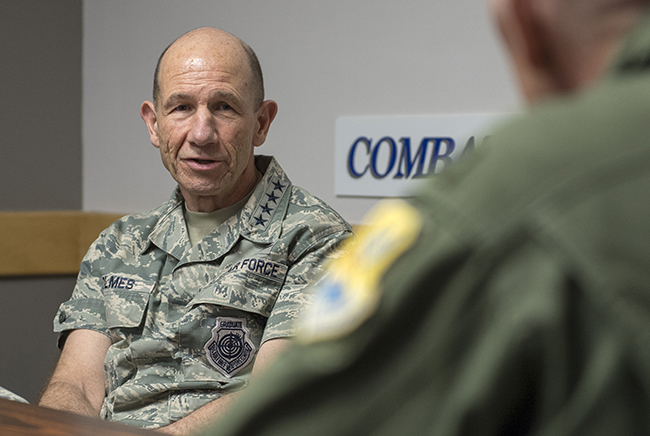
Gen. Mike Holmes, the commander of Air Combat Command, engages with senior leaders from the 124th Fighter Wing during his visit to Gowen Field, Boise, Ida., on March 28, 2019. Air National Guard photo by MSgt. Joshua C. Allmaras.
DAYTON, Ohio—Overall Air Force readiness grew by about 15 percent over the past year, but the service must revamp its approach to managing aircraft and other weapon systems to handle less predictable, more complex combat environments, Air Combat Command’s chief argued here.
“We need to fly the 16 sorties a month per airplane on Air Combat Command fighters,” Gen. Mike Holmes said in a June 19 keynote at the Air Force Life Cycle Management Center’s Life Cycle Industry Days conference. “We need to train the equivalent ways of that on our other systems, not just to check a box, and not just so I can write an update to my boss to tell them we made it. … The country is safe because of their training, so readiness is not just a number.”
Last year, then-Defense Secretary Jim Mattis issued a memo directing that the F-35, F-22, F-16, and F-18 inventories achieve mission-capable rates of at least 80 percent by the end of fiscal 2019. Air Force leaders said in written congressional testimony submitted in March that more than 90 percent of the service’s 204 “pacing” squadrons, the first group of unnamed aircraft that could be sent into a fight with an advanced adversary, were ready to deploy if needed.
“When we include their follow-on forces, these pacing squadrons are on track to reach 80 percent readiness before the end of fiscal year 2020, six years faster than originally projected,” according to the prepared testimony. “As our front-line squadrons meet their readiness goals, we will also ensure the remainder of our operational squadrons reach the 80 percent readiness mark by 2022, as we continue to build toward the 386 operational squadrons we require.”
Focused on those pacing units, the Air Force has been able to boost its ability to respond to conflict because of its current size and because it has settled into a familiar rhythm with the enduring wars of the last two decades, Holmes said.
He warned that the process works well now because the US is in a “peacetime” stance, occupied with keeping ISIS and other terror groups at bay. If the US goes to war with China or Russia, the Pentagon won’t be able to enjoy its typical supply chain and maintenance structure that depends on built-up, centralized bases. Growing the service by 24 percent to 386 operational squadrons as envisioned would further stress resources, he suggested.
“The Life Cycle Management Center has worked to squeeze the fat out and to focus on the things that are required to meet those daily requirements in a very predictable set of conflicts that are based on sending rotational units over periodically,” Holmes said. “Great power competition will be demanding in ways that require different approaches to overcoming these constraints.”
One base can’t hold 100 aircraft on their way to fight a powerful country like China and Russia: they’d be too vulnerable. The challenge calls for smaller personnel footprints, manpower and aircraft spread more thinly around the world, and a supply of parts that may struggle to reach its destination in a contested environment. Cannibalizing other aircraft for spares won’t necessarily be an option if multiple planes aren’t around to hack, Holmes said.
“Every part we can avoid having to ship, everything we can not think about because we’re more reliable will be even more important,” he continued. “We’ll be dispersed, with only a minimum number of maintainers, often multiskilling the maintainers we have to do more than one job. … Our units will have to operate more independently with what they’ve got in hand.”
He implored industry to work with the government to boost the reliability of components and subcomponents so that parts fail less often and so the Air Force can be prepared when they do. For its part, the service will continue shifting money into aircraft availability initiatives and exploring modern sustainment ideas like 3D printing and predictive maintenance algorithms. The Air Force needs to plan for those upkeep needs earlier in the development and procurement cycle, Holmes said.
ACC is also starting to adopt the idea that the historically two-part testing process should be streamlined for faster, more responsive vetting. Holmes said ACC and Air Force Materiel Command are building integrated test plans and bringing experts together in new ways for the military.
Developmental test checks whether a system meets its requirements while operational test looks at a system’s real-world performance. Driven by the success of the “Kessel Run” coding team in Massachusetts, the Air Force in the past few years has started combining those as it develops and pushes out iterative software upgrades in programs like the Air Operations Center. Critics say keeping the two pieces separate is unnecessarily drawn out and keeps the service from fixing problems faster.
“We have built some combined test forces where we have OT and DT together on the same team,” Holmes said. “We’re looking at some organizational changes on what might be the next step.”
He told reporters he expects to meet with Air Force Materiel Command boss Gen. Arnold Bunch this year to refine a path forward and he hopes to work the new testing mindset into the 2021 budget.
